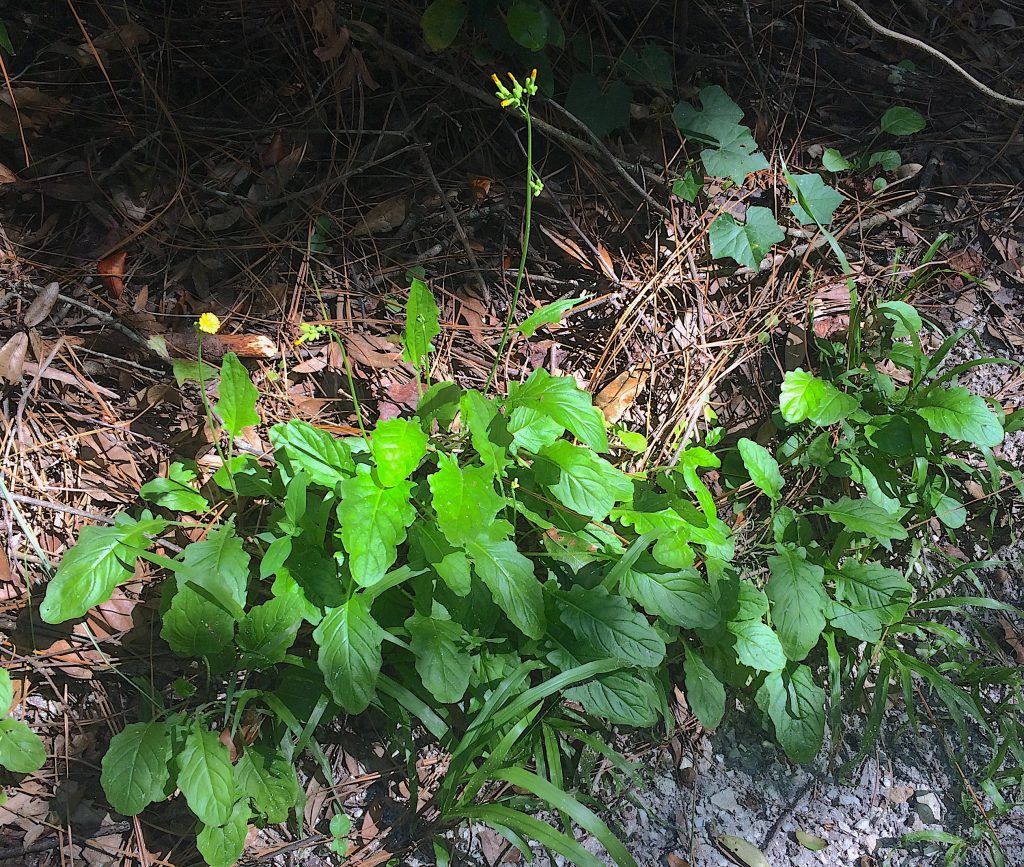
Edible False Hawk’s Beard is often mistaken for Dandelion. Read about it below. Photo by Green Deane
This is an unfair question, but if you can answer it… WOW! What do grapes, saw palmettos, mulberries, cocoplums, podocarpus and the Jambul Tree have in common? There is an answer but the “why” might be obscure: They are all blossoming or fruiting now, the wrong time of year. The “why” can have at least three reasons. One is they all can blossoms or fruit now and sometimes they do. Another reason is I just happened to notice them so I am making more out of the association than there is (interference of the measuring instrument.) A third possibility is the weather and if it is the weather what about it?
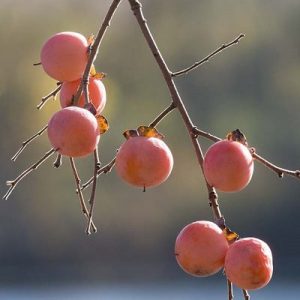
Persimmons persist after the leaves drop. Photo by Green Deane
Now some qualifications: Mulberries are a spring crop, April and May or there abouts. They fill bellies and much to the irritation of many stain sidewalks and driveways (the main reason why they were removed from many cities in southwester states. Washing the stain away took a lot of water.) I have noticed that in the fall some mulberries will put on a few fruit, very few and scattered. But, there are reports of trees in full fruit now. The podocarpus is also iffy. It usually fruits in August if kept to hedge size. But I know four podocapus trees that fruit in December. That’s odd, no idea why. The hedges are usually done fruiting by September but we found some just last week in late October. Saw Palmettos, like grapes, are usually ripe in September. But some grapes were ready to eat by late July this year and yesterday I saw grapes and saw palmettos in bloom, at least half a year off. Cocoplums fruit for several months but they usually skip our winter months but some are setting fruit now while at the same time they have fruit left over from last season. And lastly the Jambul Tree: It bears in August but I recently saw a tree in Port Charlotte blossoming and setting fruit.

Pellitory likes shade. Photo by Green Deane
If I am not making something out of nearly nothing (possible seasonality) then weather is about the only variable. The biggest possible weather event was Hurricane Irma six weeks ago which brought a lot of wind (stress) and rain (the usual signal of spring.) But there were a couple of other things. I look for ripe persimmons in October. I was eating some this year in August (before the hurricane.) And Persimmons are usually done for — that is ripe and either dropped off the trees or eaten by creatures — by Thanksgiving. I knew a tree that wasn’t ripe until January. Early in August and late January is really stretching the season. And pellitory, a cool weather edible, is usually up by Thanksgiving gone by St. Patrick’s Day. But I have found it as late as July in shade, way out of season. Perhaps these sitings are on the extreme ends of possible seasons, maybe the hurricane had some influence, or perhaps things are changing.
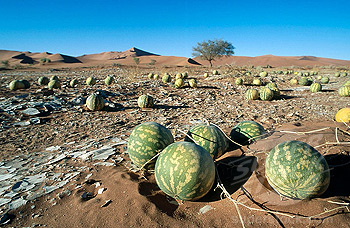
Citron Melons are native to Africa, in this case Namibia.
They are not Halloween pumpkins but you will see two types of fruit this time of year in hammocks, fields, and groves: Seminole Pumpkins and Citrons Melons. Seminole Pumpkins are a North American native that are more closely related to the butternut squash than the seasonal pumpkin of pies. Though they can be found in the wild they were also widely cultivated first by the natives and later by the settlers. They will grow on trees and have the distinct advantage of good storage in summer’s heat. And they weren’t just a southern staple. You can read about the Seminole Pumpkin here. The fruit lying around fields revealed by cooler weather and less vegetation is the Citron Melon. It’s an import from the old world before the citrus industry. That seems a bit odd as citrus groves — abandoned and tended — are common places to find the ground melon. They are native of Africa and came to the new world as a means of making preserves. Or said another way making them into preserves was a way to make them edible and store their calories for later. The melon is usually not eaten raw — they can be bitter — and have been processed in a variety of ways to make them edible … or even into fire starters. The problem is there are bitter and non-bitter varieties and botanists haven’t really bothered to sort them out and give them different names. Taste is your guide. You can read about them here.
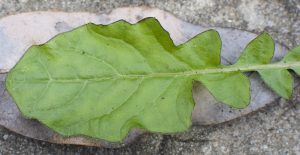
Sometimes the leaf can have a dark edge. Photo by Green Deane
It’s not a dandelion and has dozens of relatives around the world, reportedly all edible. The Flase Hawk’s Beard is here all year but it tends to favor our winter and spring sometimes getting about 20-inches high. While related to the Dandelion it’s far less picky about soil or temperatures. (Dandelions like cook temperatures and acidic soil.) The False Hawk’s Beard pictured at the top of this newsletter was growing along a woods road but you can just as easily find them in your lawn. It’s edible raw or cooked, usually the just leaves but the entire plant can be washed and consumed if you like the flavor. Unlike the Dandelion which has one stem, one blossom, and white sap, the False Hawk’s Beard has branching stems, multiple small danderlion-like blossoms, and no white sap. Want to know more about the False Hawk Beard? Go here.
Foraging Classes: One class in town this week so I can attend a local festival. By mid-month the classes will be in Ft. Pierce and Jacksonville.
Saturday, November 4th, Blanchard Park, 10501 Jay Blanchard Trail, Orlando, FL 32817. 9 a.m. Meet by the tennis courts near the WMCA building.
Saturday, November 11th, George LeStrange Preserve, 4911 Ralls Road, Fort Pierce, FL, 34981. 9a.m. The preserve is only about three miles from the junction of the Turnpike and I-95. We meet at the parking lot. This site had no formal bathrooms.
Sunday, November 12th, Florida State College, south campus, 11901 Beach Blvd., Jacksonville, FL., 32246. 9 a.m. We will meet at building “D” next to the administration parking lot.
Sunday, November 19th, Boulware Springs Park, 3420 SE 15th St., Gainesville, FL 32641. 9 a.m. Meet at the picnic tables next to the pump house.
Sunday, November 26th, Blanchard Park, 10501 Jay Blanchard Trail, Orlando, FL 32817. 9 a.m. Meet by the tennis courts near the WMCA building.
Sunday, December 3rd, Dreher Park, 1200 Southern Blvd., West Palm Beach, 33405, 9 a.m. We meet just north of the science center.
 All of Green Deane’s videos available for free on You Tube. They do have ads on them so every time you watch a Green Deane video I get a quarter of one cent. Four views, one cent. Not exactly a large money-maker but it helps pays for this newsletter. If you want to see the videos without ads and some in slightly better quality you can order the DVD set. It is nine DVDs with 15 videos on each for a total of 135 videos. Many people want their own copy of the videos or they have a slow service and its easier to order then to watch them on-line. The DVDs make a good gift for that forager you know especially on long, cold winter months. Individual DVDs can also be ordered or you can pick and choose. You can order them by clicking on the button on this page. If it is not working — the site is under reconstruction and being updated — you can go here.
All of Green Deane’s videos available for free on You Tube. They do have ads on them so every time you watch a Green Deane video I get a quarter of one cent. Four views, one cent. Not exactly a large money-maker but it helps pays for this newsletter. If you want to see the videos without ads and some in slightly better quality you can order the DVD set. It is nine DVDs with 15 videos on each for a total of 135 videos. Many people want their own copy of the videos or they have a slow service and its easier to order then to watch them on-line. The DVDs make a good gift for that forager you know especially on long, cold winter months. Individual DVDs can also be ordered or you can pick and choose. You can order them by clicking on the button on this page. If it is not working — the site is under reconstruction and being updated — you can go here.
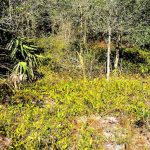
Do you know these small shrubs? You would if you joined the Green Deane Forum.
Want to identify a plant? Looking for a foraging reference? Do you have a UFO, an Unidentified Flowering Object you want identified? On the Green Deane Forum we chat about foraging all year. And it’s not just about warm-weather plants or just North American flora. Many nations around the world share common weeds so there’s a lot to talk about. There’s also more than weeds. The reference section has information for foraging around the world. There are also articles on food preservation, and forgotten skills from making bows to fermenting food. One special section is “From the Frightening Mail Bag” where we learn from people who eat first then ask questions later. You can join the forum by clicking on the button on the upper right hand side of this page.
This is issue 276. The main portion of the website is now functional though small bugs persist. We are working on them. Thanks for you patience.
If you would like to donate to Eat The Weeds please click here.

